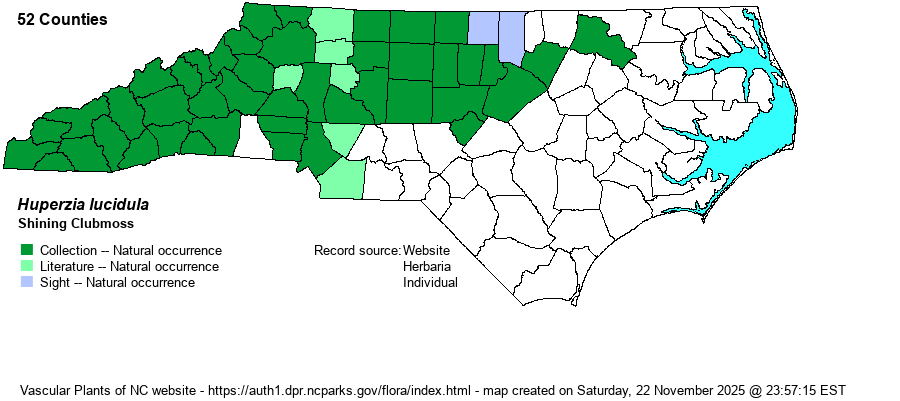| Author | (Michx.) Trevisan | |
| Distribution | Throughout the Mountains, and nearly throughout the Piedmont (though apparently absent from the southeastern portion and some northeastern counties). Not known from the Coastal Plain. The Lee County population was discovered by Jimmy Randolph in 2016.
This is a Northeastern and Eastern species, quite widespread in its range -- from eastern Canada south to central NC, northwestern SC, northern GA, northern AL, and northern AR. Apparently disjunct to China (Weakley 2020).
| |
| Abundance | Common and widespread in the Mountains; fairly common at least locally in the northern and central Piedmont (more numerous near the VA line), but rare in the northeastern and southeastern counties. | |
| Habitat | This is a soil-based species, growing in cool, moist forests of various types, often under conifers or mixed canopy. It may grow in ravines and in seepages and somewhat damp places, but almost always where shaded and in cool microclimates. |
| Phenology | Fruits from June to August. | |
| Identification | This is a quite familiar evergreen species of the western and central parts of the state. This plant has several ascending branches, reaching about 6-8 inches tall, with small oblanceolate leaves densely packed in mostly 6 ranks. The leaves are about 2/5-inch long, spreading to deflexed, and shiny dark green in color. Owing to the relatively "large" leaves and their spreading aspect, the width of a branch can be close to 3/4-1 inch across. Some of the branches have additional ascending branches. This species should not be confused with any other firmoss or clubmoss, as others grow on exposed rocks or in wet seepages and have smaller and more lanceolate leaves. | |
| Taxonomic Comments | Most older references named this as Lycopodium lucidulum.
| |
| Other Common Name(s) | Shining Firmoss. When this and other Huperzia species were included within the large genus Lycopodium, most species had common names of "xxxxx Clubmoss". With some of them split out into Huperzia, there is a trend to call these species as "xxxxx Firmoss". Most references still use Shining Clubmoss as the preferred common name. | |
| State Rank | S5 | |
| Global Rank | G5 | |
| State Status | | |
| US Status | | |
| USACE-agcp | FACW link |
| USACE-emp | FACW link |

